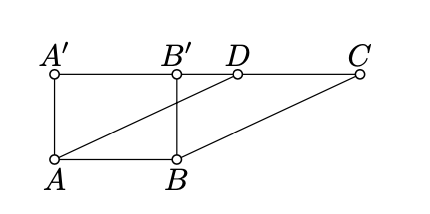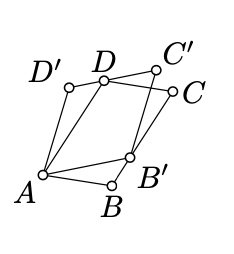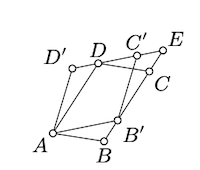20.6: Área de paralelogramos sólidos
- Page ID
- 114509
Dejar\(\square ABCD\) ser un paralelogramo en el plano euclidiano,\(a=AB\) y\(h\) ser la distancia entre las líneas\((AB)\) y\((CD)\). Entonces
\(\text{area }(\blacksquare ABCD)=a\cdot h.\)

- Prueba
-
Dejar\(A'\) y\(B'\) denotar los puntos del pie de\(A\) y\(B\) en la línea\((CD)\).
Tenga en cuenta que\(ABB'A'\) es un rectángulo con lados\(a\) y\(h\). Por Teorema 20.5.1,
\[\text{area }(\blacksquare ABB'A')=h\cdot a.\]
Sin pérdida de generalidad, podemos suponer que\(\blacksquare ABCA'\) contiene\(\blacksquare ABCD\) y\(\blacksquare ABB'A'\). En este caso\(\blacksquare ABCA'\) admite dos subdivisiones:
\(\blacksquare ABCA'=\blacksquare ABCD\cup\blacktriangle AA'D=\blacksquare ABB'A'\cup\blacksquare BB'C.\)
\[\begin{aligned} \text{area }( \blacksquare ABCD)&+\text{area }(\blacktriangle AA'D)= \\ &= \text{area }(\blacksquare ABB'A')+ \text{area } (\blacktriangle BB'C). \end{aligned}\]
Tenga en cuenta que
En efecto, dado que los\(ABB'A'\) cuadriláteros y\(ABCD\) son paralelogramos, por Lemma 7.5.1, tenemos eso\(AA'=BB'\),\(AD=BC\), y\(DC=AB=A'B'\). De ello se deduce que\(A'D=B'C\). Aplicando la condición de congruencia SSS, obtenemos 20.6.3.
En particular,
\[\text{area }(\blacktriangle BB'C)=\text{area } (\blacktriangle AA'D). \]
Restar 20.6.4 de 20.4.2, obtenemos que
\[\text{area } (\blacksquare ABCD)=\text{area }(\blacksquare ABB'D).\]
Queda por aplicar 20.6.1.
Supongamos\(\square ABCD\) y\(\square AB'C'D'\) son dos paralelogramos tales que\(B'\in[BC]\) y\(D\in [C'D']\). Demostrar que
\(\text{area }(\blacksquare ABCD)=\text{area }(\blacksquare AB'C'D').\)

- Pista
-
Supongamos que\(E\) denota el punto de intersección de las líneas\((BC)\) y\((C'D')\).

Utilice Proposición\(\PageIndex{1}\) para probar las dos identidades siguientes:
\(\begin{array} {l} {\text{area } (\blacksquare AB'ED) = \text{area } (\blacksquare ABCD),} \\ {\text{area } (\blacksquare AB'ED) = \text{area } (\blacksquare AB'C'D')} \end{array}\)


